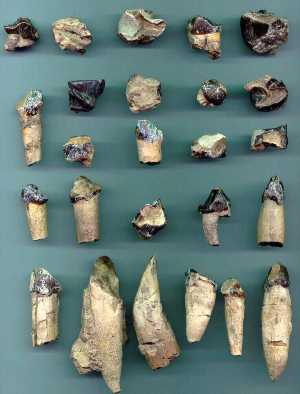
Here's a collection of Coryphodon teeth from the Eocene Period. These teeth were collected in the Big Horn Basin of Wyoming.
Coryphodon was a heavy built mammal with very thick bones, which restricted destruction, so many fossils of this animal are found in the Wyoming area. This animal was about the size of a Tapir or an Ox, weighing 1,600 to 1,800 pounds. Coryphodon was about 8 feet long, with short legs, and five toed feet. The skull was large and blunt and the canine teeth became tusks and probably aided the males in fighting.
Cave Bear Foot

Ursus uralensis (Cave Bear) lived during the Pleistocene Period in the Ural Mountains in Russia. This bear is an extinct species, popularly known as the cave bear from it's habit of inhabiting caves, where the remains are frequently preserved; in European cave deposits, the remains, of more than 100,000 cave bears have been found. It appears that most cave bears died in the severe glacial winters during the hibernation; the remains include a large proportion of very young and very old and many specimens showing unmistakeable signs of illness and disease. This foot measures 11 inches tall.
Platygonus compressus, flat headed peccary

These are three lower jaws of the "Flat Headed Peccary" (Platygonus compressus). This animal lived during the Pleistocene Period, it stood about 30 inches high at the shoulders. These jaws were collected from a site 10 miles north of Athol, Kansas.
Saber Tooth Tiger

Skull of Smilodon californicus (Saber Tooth Tiger). This skull is a cast, the original is in the Los Angeles County Museum. These remains were found in the La Brea Tar Pits in Los Angeles.
Teleoceras proterum, tooth

This is the tooth of one of the round bodied, stubby-limbed, and broad footed rhinoceroses. Abundant remains have been found all across North America in early Pliocene deposits.